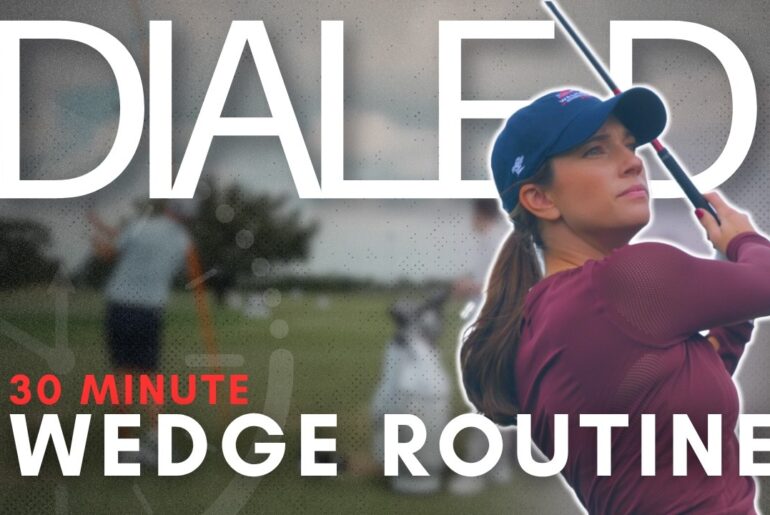This video is specifically for players who struggle with:
Heavy contact ✅
Hooks ✅
Pushes ✅
(⚠️ If these aren’t your common misses, then what’s in this video could actually make things worse!)
This lesson is inspired by Alex Noren’s recent win at The Belfry. Known as one of the hardest workers on tour, Noren has been drilling this feel for over a decade.
The drill focuses on the shoulder and pelvic tilts in the downswing, which helps to:
Move the low point forward✔️
Shift the club path left✔️
Increase shaft lean✔️
If you often feel “stuck,” catch the ground heavy, or see a higher-than-expected ball flight, this could provide some really useful direction.
And one more big takeaway: watching how Noren trains with deliberate exaggeration is a powerful reminder of what it actually takes to make fast, lasting changes.
So, in this video, we’re really going to cover some characteristics in the swing that create heavy contact. So, getting the club, the club bottoming out before the ball. So, ground first, then ball, or potentially thin shots where there’s no interaction with the ground. It’s also normally matched with a ball that curves too far to the left for a right-handed player. So, you can get hook shots and push shots. So, if you’re struggling with heavy contact hooks and pushes, this video is worth a watch. So, we’re going to focus in on the pelvic tilt and the shoulder tilt through down swing for this analysis. So, if I put an alignment stick through my belt loops just to give us a representation of the tilting of my pelvis and also the tilting of my shoulders. So for players struggling with the heavy contact, the pushes or the hooks, typically something that will come across often is in the down swing, we’ll see the pelvis tilt and the shoulder tilt work too far behind the ball through transition and into the down swing. So the trail side of the pelvis gets below the lead side too early. The same with the trail shoulder. So this creates a delivery of the club where the low point is very often behind the ball and a club path that travels too far to the right. So for this player, essentially what we’re trying to create is a feeling of once we get to the top of the swing, we’re trying to get a sensation of the lead side of the pelvis and the lead shoulder staying lower for longer through transition. So that down swing piece would be feeling the left side stay lower than the right side. Now, if you’re used to using the tilting of the pivot to shallow the club, we’ve got to then replace that with a new feel. So, if I’m if I’m making my down swing and I’m feeling my left side lower, I really have to feel like I’m working my arms more down. So, my trail shoulder staying up and back as I’m moving my arms down, which is going to be what keeps that club in a good delivery position whilst also maintaining good tilt with my shoulders and my pelvis. That puts me in a position there now where I can begin to open up. The club’s going to start bottoming out after the golf ball and the hand path is going to work into the left which creates that club path to take the curve off the ball. There’s no better player to have a look at this being done to the extreme than recent winner Alex Noran. He works on this constantly in order to improve these characteristics. Let’s take a look. So the video on the left here is Alex Noran working through this exact feel. So you’ll really notice how exaggerated and how much he’s overdoing this movement. So you’ll really see as he makes his transition just as we’re rehearsing there, he’s keeping his shoulder tilt very much angled down towards the ground with his shoulders. His lead hip is down low and rotating open. And as he gets into delivery, he’s lowered his arms so they’re back underneath his chest. So he’s in a position that is very much overdone, but an exaggeration that he needs to feel in order to get close to where he wants to be for his actual golf swing. So if we take a look at his actual swing here on the right from face on, you’re going to see some great characteristics as he makes his transition. You’ll see his shoulder tilt, his lead shoulder stay lower than his trail shoulder. You’ll also see his pelvic tilts angled slightly down. So, this is exactly what his practice swing is going to help him achieve in his golf swing. But in reality, when he does it with a golf ball, as he gets close to impact, he’s going to be in reality much more level with the pelvis coming into impact and much more level with the shoulders, but still in a great position to get the low point forward and create that great inward and upward hand path that he’s working on to take the curve left out of play and to move the low point forward. So, it’s always great watching Norin practice because he uses a lot of exaggeration in his practice drills. And that’s one of the reasons if you’ve been working on a new movement, you’ve been working on a change, but haven’t seen a change. That’s one of the reasons that can be holding you back, not exaggerating the feel enough. Cuz you saw there between what he was trying to feel versus what he was actually doing were two very different things. But to to get to there, he’s got to feel that exaggerated rehearsal motion. So, as you rehearse that, let’s say from down the line, you’re really feeling left side stays lower, lead side stays lower. Now, as that works the hand path down and out, I’m still keeping the club head, the shaft behind my hands. So, from there, I now have room for my hand path to work in up and to the left, which is then going to passively throw that club head out on top of the ball. So, it’s a lovely combination of being shallow early in the down swing and being steep late, which is a really good combination for players that get stuck underneath, battling with the heavy strike or the ball that curves too much to the left. So, the feeling there is left side lower, club behind, and just getting that set up so that the club can then arc into the left. So from a down the line perspective, you’ll see the hand path working to the left, club head staying more or less outside the hands. Really, really good. And then from face on, which is key for the contact. Now again, we’re exaggerating this, but if I’m working lead side down and left, and I’m also getting feeling here like my upper center is actually in front of my pelvis. So that’s way too much for an actual golf shot. But that’s often how much you might need to feel this. Now, if I do that, that really gets the club bottoming out a long way after the ball. So, the low point moves a good few inches after the ball, which is a really good practice swing if you’re a player who struggled with the trail side being lower than the lead side and the club bottoming out too far behind. So, you can work on that drill. Use a mirror. Use video for feedback. Really work on those pelvic tilts. Work on the shoulder tilts. Exaggerate it. Use Alex Narn as a great example of how much and how to actually practice the motion. Use video for feedback. And you’re going to see that low point move forward and that curve greatly reduced.








1 Comment
The wear mark on that iron 😮